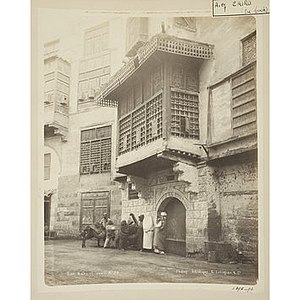Bayt Al-Razzaz Palace
Description

Originally built in the 15th century during the Mamluk era, Bayt al-Razzaz is a mansion now comprising two houses, two central courtyards, and other utility structures such as stables, baths, storerooms, etc. The number of buildings along with its size gives the structure the impression of being palatial. The two properties, which collectively comprise 190 rooms, were connected via a single passageway sometime in the early 19th century, as a result of a marriage contract.

The first house (eastern side) was built in around 1480 by Sultan Qaytbay and features highly decorative mashrabiya windows on the second floor, overlooking the street and others looking out over the courtyard. One of the doorways on the eastern side of the courtyard is decorated in the Mamluk style and includes the cartouche or blazon of Qaytbay. The structure is primarily of stone and brick, with carved wooden windows. Interior walls and ceilings are of finely painted wood panels. The flat roof is constructed of layers of mortar over horizontal sheathing boards. The second floor was used as the women's quarters while the downstairs area was occupied by the men.
The second house (western side) was built by a wealthy rice merchant, Ahmad Katkhuda al-Razzaz, in the 18th century, probably to accommodate a growing family and an increasingly complex network of relationships. The buildings were occupied by the same families for centuries.
Situated in Darb al-Ahmar neighbourhood, the complex occupies a vast area and is bounded by Bab al-Wazir Street on one side, and the Suwayqat al-'Izza/Suq al-Silah on the other, with entrances on both streets, and is adjacent to the Mosque of Umm Sha'ban.
The structure was abandoned in the 1960s, and became the property of the Ministry of State for Antiquities (formerly the Supreme Council of Antiquities). From the late 1970s, a team led by American Research Center in Egypt carried out restoration work on the eastern complex which were completed in 2007. The western building remains in need of restoration and the Ministry has plans to restore it for use as offices, however in light of the political unrest in Egypt, the World Monuments Fund considers the project to be "at risk".
Gallery
-
Entrance to Bayt al-Razzaz, photograph by Gabriel Lekegian, late 19th century
-
Courtyard of the palace
-
Eastern front seen from the courtyard
-
Blazon of Qaitbay above the eastern door lintel
See also
- Madrasa of Umm al-Sultan Sha'ban
- Islamic architecture
- K. A. C. Creswell - architectural historian and photographer who documented Bayt al-Razzaz and other historic buildings in Egypt in the late 18th century
- Mamluk architecture
- Ottoman architecture
References
- ^ Williams, C., Islamic Monuments in Cairo: The Practical Guide (6th ed.), American University in Cairo Press, 2008, p. 89
- ^ O'Kane, B. (ed.), Creswell Photographs Re-examined: New Perspectives on Islamic Architecture, American University in Cairo Press, 2009, pp 54-55; Apparently a member of the al-Razzaz family married a member of the family occupying the neighbouring property, resulting in the two properties being joined.
- ^ Williams, C., Islamic Monuments in Cairo: The Practical Guide, American University in Cairo Press, 2008, p. 89
- ^ Williams, Caroline (2018). Islamic Monuments in Cairo: The Practical Guide (7th ed.). The American University in Cairo Press. pp. 106–107.
- ^ Morton, W. Brown (1997). "The Bayt al-Razzaz Palace: Developing an Existing Conditions Report". APT Bulletin: The Journal of Preservation Technology. 28 (2/3): 44–50. doi:10.2307/1504533. ISSN 0848-8525.
- ^ Fay, M-A., Unveiling the Harem: Elite Women and the Paradox of Seclusion in Eighteenth Century Cairo, Syracuse University Press, 2012 p. 202
- ^ Williams, C., Islamic Monuments in Cairo: The Practical Guide, American University in Cairo Press, 2008, pp 89-90; Fay, M-A., Unveiling the Harem: Elite Women and the Paradox of Seclusion in Eighteenth Century Cairo, Syracuse University Press, 2012 p. 202
- ^ Fay, M-A., Unveiling the Harem: Elite Women and the Paradox of Seclusion in Eighteenth Century Cairo, Syracuse University Press, 2012 p. 202
- ^ Williams, C., Islamic Monuments in Cairo: The Practical Guide, American University in Cairo Press, 2008, p. 89
- ^ Morton, W. Brown, "Bayt al-Razzaz: The challenge of adaptive use for a vacant Mamluk palace in Cairo," International Journal of Heritage Studies, Vol. 3, no. 3, 1997, pp 135-143, DOI: 10.1080/13527259708722200; Bacharach, J.L., The Restoration and Conservation of Islamic Monuments in Egypt, American University in Cairo Press, 1995, p. 18
- ^ World Monuments Fund, "Bayt al-Razzaz," Online
Further reading
- UNESCO article
- Bloom, J. and Blair, S., Grove Encyclopedia of Islamic Art & Architecture, Vol. 1, Oxford University Press, 2009, p. 121
External links
- American University of Cairo, Digital Collection, Photographs of Bayt al-Razzaz by K.A.C. Creswell, late 19th-century Online:




